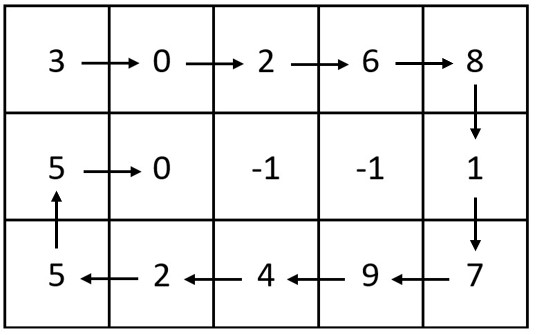You are given two integers m and n, which represent the dimensions of a matrix.
You are also given the head of a linked list of integers.
Generate an m x n matrix that contains the integers in the linked list presented in spiral order (clockwise), starting from the top-left of the matrix. If there are remaining empty spaces, fill them with -1.
Return the generated matrix.
Example 1:

Input: m = 3, n = 5, head = [3,0,2,6,8,1,7,9,4,2,5,5,0]
Output: [[3,0,2,6,8],[5,0,-1,-1,1],[5,2,4,9,7]]
Explanation:
The diagram above shows how the values are printed in the matrix.
Note that the remaining spaces in the matrix are filled with -1.
Example 2:

Input: m = 1, n = 4, head = [0,1,2]
Output: [[0,1,2,-1]]
Explanation:
The diagram above shows how the values are printed from left to right in the matrix.
The last space in the matrix is set to -1.
Constraints:
- 1 <= m, n <= 105
- 1 <= m * n <= 105
- The number of nodes in the list is in the range [1, m * n].
- 0 <= Node.val <= 1000
这题包含一个暗示, 就是这个矩阵的格子数量一定是大于链表的节点数量的。 我们首先生成 m * n 的矩阵, 每个格子填充-1, 然后遍历链表同时填充矩阵, 我们从 matrix[0][0]开始, 一开始的方向是向右, 如果遇到矩阵的边界或者已经填充的格子(值不为-1), 则换方向, 方向转换方式为: 右 -> 下 -> 左 -> 上 -> 右
impl Solution {
pub fn spiral_matrix(m: i32, n: i32, mut head: Option<Box<ListNode>>) -> Vec<Vec<i32>> {
let mut matrix = vec![vec![-1; n as usize]; m as usize];
let mut row = 0usize;
let mut col = 0usize;
let mut dir = "right";
while let Some(node) = &mut head {
matrix[row][col] = node.val;
match dir {
"right" => {
if col == n as usize - 1 || matrix[row][col + 1] != -1 {
dir = "down";
row += 1;
} else {
col += 1;
}
}
"down" => {
if row == m as usize - 1 || matrix[row + 1][col] != -1 {
dir = "left";
col -= 1;
} else {
row += 1;
}
}
"left" => {
if col == 0 || matrix[row][col - 1] != -1 {
dir = "up";
row -= 1;
} else {
col -= 1;
}
}
_ => {
if row == 0 || matrix[row - 1][col] != -1 {
dir = "right";
col += 1;
} else {
row -= 1;
}
}
}
head = node.next.take();
}
matrix
}
}







 本文介绍了一种算法,该算法接收两个整数m和n作为矩阵的维度,以及一个整数链表,生成一个m×n的矩阵,其中链表中的整数以螺旋顺序填充到矩阵中,剩余位置用-1填充。
本文介绍了一种算法,该算法接收两个整数m和n作为矩阵的维度,以及一个整数链表,生成一个m×n的矩阵,其中链表中的整数以螺旋顺序填充到矩阵中,剩余位置用-1填充。
















 1586
1586

 被折叠的 条评论
为什么被折叠?
被折叠的 条评论
为什么被折叠?








